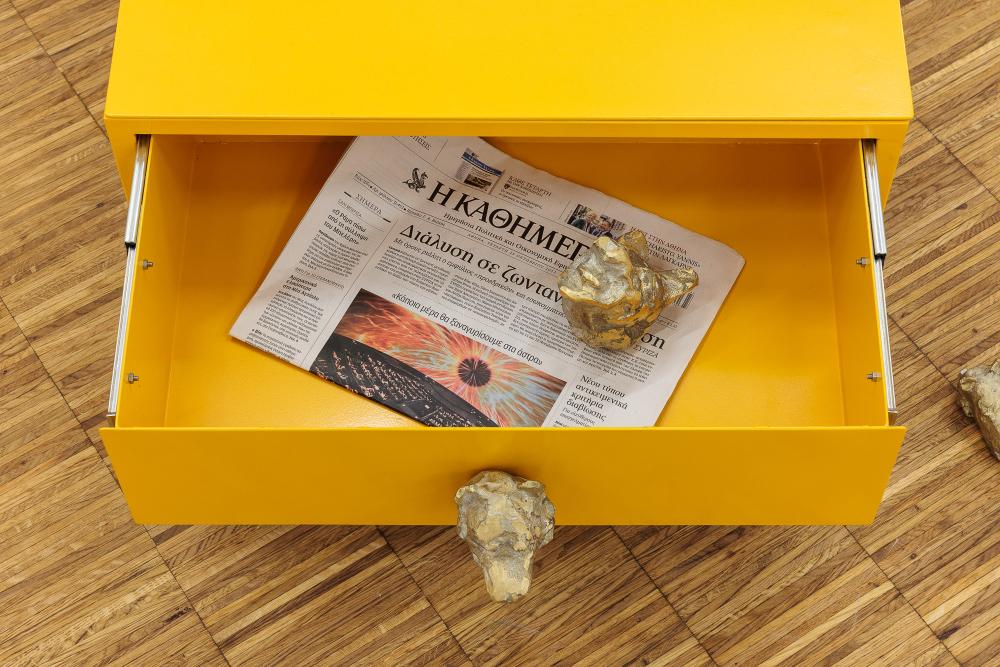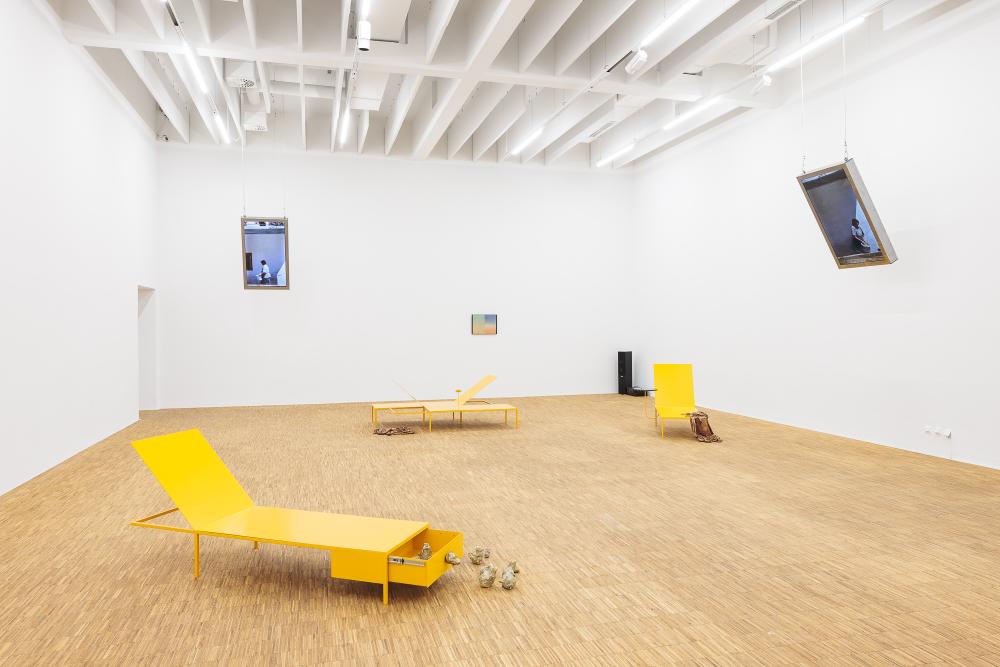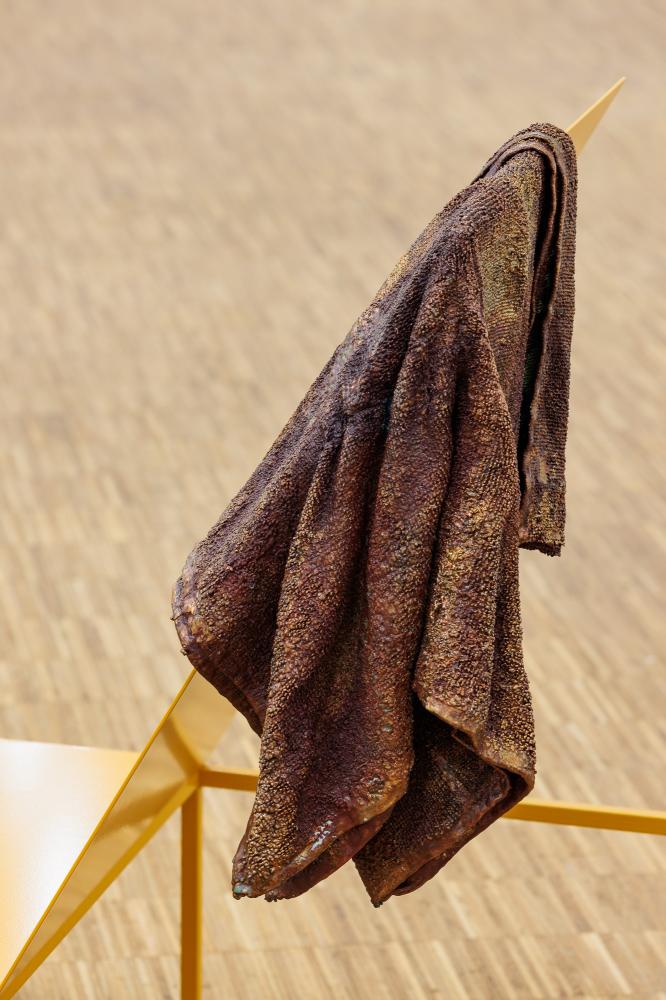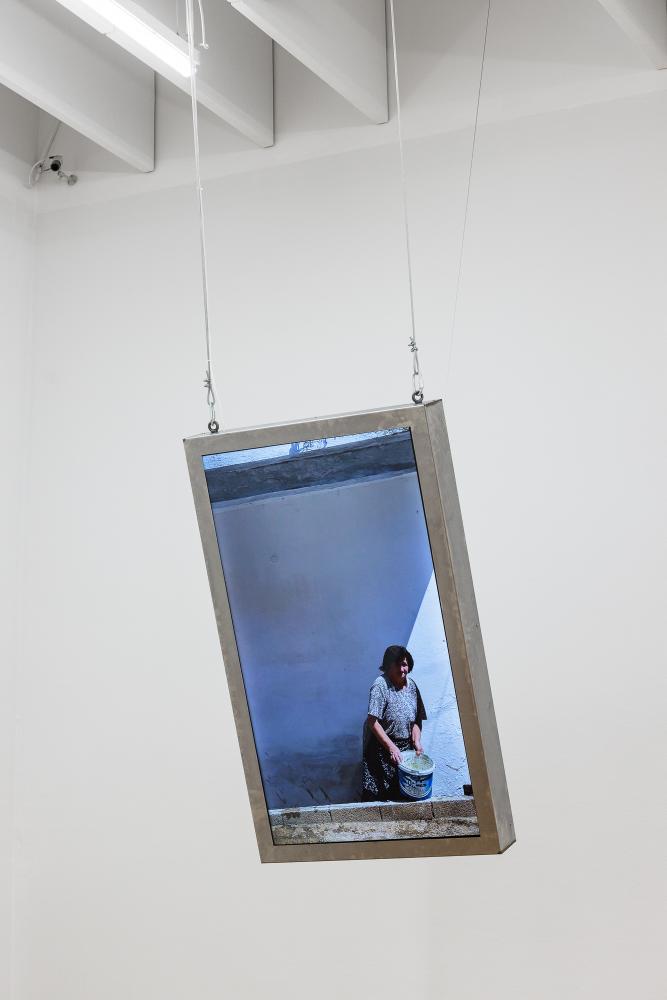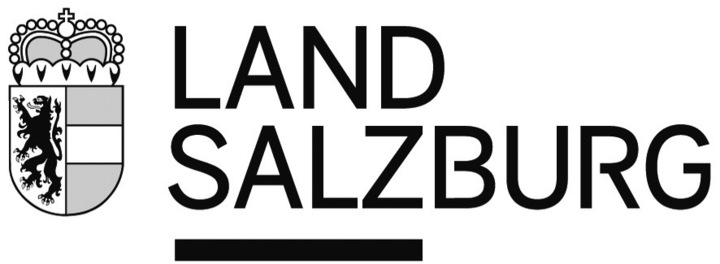



Under the shimmering sun in a small village of Albania, a scene unfolds, almost hypnotic in its simplicity. An elderly woman stands in front of a house with bucket of water in her hands, tourists are passing by. With a deliberate motion, she casts the water onto the ground, the liquid arches gracefully before it meets the surface. This might seem a mere quirk of daily life, or method to lay the dust or cool the dry ground. The women’s action is however not arbitrary but a ritual farewell, a Balkan tradition where water is thrown in the wake of departing guests, signifying a wish for their return, a path made smooth and a hope that they, like water, will find their way back home. Captured in the video loop by Vasilis Papageorgiou, this scene opens his exhibition Sunseekers or Dimming the Sun or, inviting us into a contemplation on the capitalist systems of pleasure, their role in the cyclical depletion of planetary resources, and the loop these create in relation the need for rest and regeneration.
At its core, the exhibition Sunseekers or Dimming the Sun or navigates through two distinct discourses, as hinted at in its title. The tourism industry's emblematic “sunseekers”—those who chase the warmth and follow the promise of endless pleasure under the sun—are juxtaposed with the idea of “dimming the sun,” which emerges from the climate crisis lexicon as a drastic measure to cool the earth[1]. Papageorgiou’s choice to punctuate the exhibition title with an additional “or” hints at a realm of possibilities beyond this dichotomy, suggesting an exploration of alternatives, or perhaps, an unresolved question into the future we are collectively authoring. It is in this speculative space that the exhibition finds its expression.
Amidst the array of yellow[2] metal sunbeds that fill the exhibition space, one in particular captures attention. This distinct sunbed hosts a small screen, pulling us into a looped video of an urban scene, sharply contrasting with the expected beachscape. This piece transports viewers to the Place des Vosges in Paris, where children play in a fountain amidst a heatwave. One can speculate if this act might evolve into a future ritual; a ritual born of necessity in the face of rising temperatures, hinting at a desire for a paradigm shift in how we conceive of development and progress, for a world that is cooler, more balanced, and more harmonious in the relationship with our environment.
Fountains as beaches draw people together; they are quintessential gathering spots. Both spaces, though differing in their elements, serve as the communal feeling where social interaction and a sense of belonging are fostered. While fountains invite passersbys to pause and reflect, to observe the beauty of water in its controlled elegance, beaches offer a coming-together with strangers in a sense of relief through expansive horizons and rhythmic waves. The architecture of sunbeds within Sunseekers… and that of a fountain at Place des Vosges, engage in a silent dialogue about leisure, nature, and human intervention. The sunbeds, transformed through Papageorgiou into objects of contemplation, reflect on the cycle of leisure, its environmental implications, and exhaustion. For one of the sunbeds Papageorgiou transformed a towel, an object left behind as forgotten remnant of a day under the sun, into sculpture. The act of wrapping it in copper, of giving it new worth, elevates a mundane object to a piece of art, suggesting a reconsideration of value—much like how fountains repurpose water, an everyday element, into a source contemplation. Another sunbed hosts a solitary flower. This flower stands as a testament to the relationship between tourism's toll on nature and its resilience. There is also a sunbed with a drawer containing a newspaper proclaiming a “return to the stars,” a metaphorical dive into the cosmos that juxtaposes the global with the intimate. The presence of bronze sculptures around this sunbed speaks to the transient nature of human achievements, a theme that also resonates with the flowing water of fountains, which, despite appearing the same from moment to moment, is always changing, always moving forward. Lastly, the fifth sunbed is featuring a green marble and a cast bronze ring. The marble, sourced from the depths of the Earth, and the ring, a transformed piece of plastic, speak again to the cycles of transformation of value. These sunbeds, in their deliberate composition, become the or-spaces where the light of leisure meets the shadow of tourism’s environmental impact, urging us to ponder our place between the aspiration of pleasure and the sustainability of our planet.
One last element in the exhibition takes an immaterial form of a fragmented soundscape—it’s a sonic thread that stitches together seven hours of sound and silence, creating an experience where each listener becomes a traveler, syncing with the passing day and the exhibition opening hours. The piece is based on the sound of a clarinet—an instrument, carried from German-Austrian regions to the Balkans and Greece by the Roma people. The soundscape prompts reflection on how the act of carrying something as simple as a musical instrument from one place to another can encapsulate stories of migration and adaptation. It embodies the fluidity of cultural identity and the passage of traditions across borders, showing how musical cultures absorbing influences and reshape them into something uniquely their own. As the day wanes, the sound stretches, reaching into the realms of memory, each fragment evoking places seen or unseen. And that’s what Sunseekers or Dimming the Sun or feels like: a conversation across time and space, held together by the notes of a clarinet that’s seen more of the world than most of us ever will.
—Mirela Baciak
[1] The phrase dimming the sun stems from scientific discourse surrounding solar radiation management (SRM)—a geoengineering solution proposed to mitigate climate change by artificially dimming the sun’s rays.
[2] The sun-beds are painted with 3034 Sun Yellow.
Credits:
Curator: Mirela Baciak
Sound designer: Dimitris Prokos
Studio coordinator: Mariana Antzoulatou
Blacksmiths: Thanos Vasileiou & George Frantzoglou
Copper technician: Dimitris Philippakis
Marble technicians: Earth Marbles by Malevitis
Ceramicist: Daphne Leon
Thank you Olympia Tzortzi (Callirrhoë), Paola Bonino & Marta Barbieri (UNA Galleria)
The exhibition is commissioned and produced by Salzburger Kunstverein.
Vasilis Papageorgiou (*1991, Athens, Greece) is an artist based in Athens. His work has been showcased in notable exhibitions, including the 7th Athens Biennale – Eclipse (2021), Benaki Museum (2019), Stavros Niarchos Cultural Foundation (2019), and MAXXI - the National Museum of 21st Century Arts (2019). He also participated in the 6th Moscow International Biennale for Young Arts (2018), among others. Additionally, Papageorgiou is a co-founder of Enterprise Projects, an initiative and project space in Athens, established in 2015, that focuses on artist and curator collaborations.
Photo on top: Vasilis Papageorgiou, Sunbed IV (double), 2024, painted steel, 213 x 120 x 82 cm. Exhibition view Vasilis Papageorgiou Sunseekers or Dimming the Sun or, Salzburger Kunstverein 2024, photo: kunst-dokumentation.









